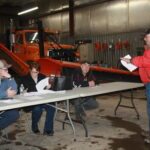To the editor:
On August 1, 2007, the Maine Department of Environmental Protection (MDEP) finalized “In-Stream Flow and Lake and Pond Water Levels Standards” that regulate certain surface water uses, including agricultural irrigation. The intent of these rather complex rules (effective Aug. 24, 2007) is to balance the need to provide safe and dependable public and private water supplies with the need to protect aquatic life and other water quality standards. The new rules do not apply to ponds constructed outside of a natural stream channel for the purpose of storing water for later use. Although the in-stream flow standards are year round, the prescribed seasons of interest to agriculture would be early summer (May 16 to June 30) and summer (July 1 to September 15). “Seasonal aquatic base flow” to be maintained in early summer is generally a flow equal to the June median stream flow; in summer the base flow to maintain is generally a flow equal to the median August stream flow.
Most tributaries of the lower Aroostook River are Class B waters. In general, flow requirements established by the “standard allowable alteration” for Class B waters may not be less than the seasonal aquatic base flow, except when natural conditions alone cause those flows to be less.
For lakes and ponds where the water is controlled by a dam and is not used for hydropower storage or generation (Arnold Brook Lake, Echo Lake, Monson Pond and Trafton Lake), withdrawals are limited to 1 acre-foot of water per acre of the waterbody at normal high water from April 1 to July 31, and a total of two acre-feet of water per acre of the waterbody at normal high water from August 1 to March 31. Additional volume increments may be withdrawn whenever it can be “demonstrated” that water replacement has occurred.
Agricultural producers irrigating with direct withdrawals from a brook or stream, could face a loss of supply at critical times. Based on my analysis of historical Web-based daily flows recorded by the U.S. Geological Survey, it appears that had these standards been in place during the 2001 “flash drought,” direct withdrawal from the Aroostook River and her many tributaries would likely have been prohibited – throughout much of August.
Steve Sutter
Presque Isle







